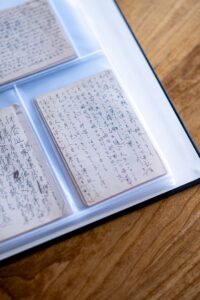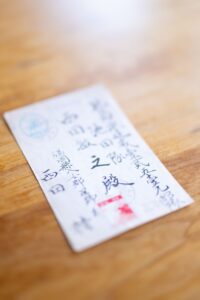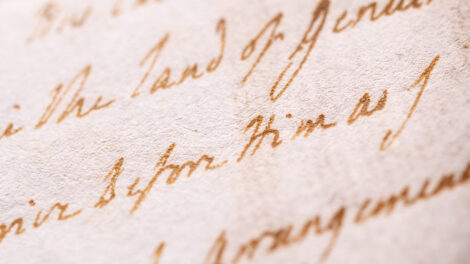Skillman’s Japanese postcard collection attracts international attention
By Bryan Hay
Mid-20th-century postcards in the College Archives provide a rare glimpse into the deep concern felt by Japanese civilians about the condition of military friends and family at the end of World War II and continue to attract international attention.
Paul Barclay, professor of history and general editor of the archives’ East Asia Image Collection, worked with a camera crew and reporter from NHK, Japan’s public broadcasting system, during their visit to Skillman Library last summer. A documentary about the postcards was recently aired on NHK.

Paul Barclay, professor of history and general editor of the archives’ East Asia Image Collection
The 400 postcards in the collection were written in Japan in the months immediately after the end of World War II. Families and friends of Japanese soldiers sent postcards to POW camps and war zones in the Philippines with messages seeking information about their whereabouts and condition of their loved ones in the military. Absent a working Japanese postal system after the war, the postcards were never delivered.

A news crew from Japan’s public broadcasting system visited Skillman Library to produce a documentary about the postcards.
The postcards found their way to Lafayette through a former student of Barclay’s, Brett Doyle ’11, whose father had them stored in boxes in his attic. He acquired them years ago from an American soldier who served in the Pacific during the war.
“They didn’t know what they were, so they brought them to me. And I could read them and I loved them and the stories they held about what was going on in the minds of people living in Japan at the end of World War II,” says Barclay, whose academic interests include Imperial Japan and East Asian history.
The Doyle family donated the postcards to Lafayette, and digital copies were shown to staff at a national museum in Tokyo. Soon after, NHK found out about the collection and made arrangements to send a team to Lafayette College and interview Doyle’s father at his home in Connecticut.
“The museum in Tokyo really did a lot of sleuthing and figured out that these postcards went to staging areas in Tokyo and Yokohama to be sent to the Philippines, before the U.S. occupational government had established any post-war infrastructure,” says Barclay, noting that the postcards either got lost or were never sent.
Many of the sentiments expressed on the postcards are tender and sweet: Dad, we miss you. Come home soon; someone’s getting married; the Americans are not that bad.
“They’re little pictures of life,” Barclay observes as he focuses on a postcard made by schoolchildren and its delicate, abstract lithography. “Some of them relay a hope that victory might still be possible. But most are quite precious and reflect everyday life and people missing their relatives. There’s one that says a favorite brand of beer will be waiting for them when they come home.”

The postcards from the end of World War II provide “little pictures of life,” says Prof. Barclay.
Barclay enjoys bringing his students to Skillman Library to examine the postcards and other items in the East Asia Image Collection.
“It puts you in a different historical context,” he says. “Students look at this material and handle it to think about it. They think about text and images, and a piece of correspondence that has materiality, weight, size, and form. The digital world has flattened that out. Tactile and visual, these collections reveal an earlier world, showing how people used to communicate with one another.”
Along with NHK and his students, Barclay has shown the Japanese postcard collection to visitors from across the United States and Japan, journalists, and a Harvard University librarian.
“The collection also mitigates stereotypes about Japan that we get from watching war movies,” Barclay says. “What’s shared are common concerns that would resonate with anyone living in a war zone. They’re modern people with meaningful relationships and concerns.”
Learn more about Lafayette’s East Asia Image Collection.

